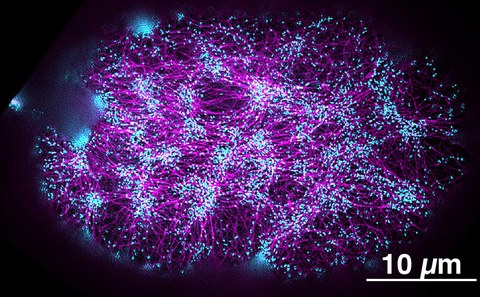18.05.2021
Rotierende Kräfte bringen Embryos in Form

Bild des Aktomyosin-Kortex in einem einzelligen Embryo, aufgenommen mit hochauflösender Fluoreszenzmikroskopie. Die Aktinfilamente sind magentafarben markiert, die Bereiche, in denen Kräfte und Drehmomente erzeugt werden, sind cyanfarben markiert.
Dresdner Forscher entdecken, wie ein Protein Rotationskräfte erzeugt, die für die Entwicklung von Tieren wichtig sind.
Von außen betrachtet sieht unser Körper symmetrisch aus. Wenn man jedoch einen Blick ins Innere wirft, sind unsere Organe keineswegs symmetrisch angeordnet. Das Herz zum Beispiel befindet sich auf unserer linken Seite. Diese Unterschiede, die als Links-Rechts-Asymmetrie bezeichnet werden, bilden sich schon in der frühen Entwicklung eines Embryos aus, und sind entscheidend dafür, dass sich ein Embryo ordentlich und korrekt entwickeln kann. Forscher haben in früheren Studien herausgefunden, dass Drehmomente, also Kräfte die Drehungen bewirken, bei der Entstehung von Links-Rechts-Asymmetrien eine wichtige Rolle spielen. Nun haben Wissenschaftler des Max-Planck-Instituts für molekulare Zellbiologie und Genetik (MPI-CBG), des Biotechnologischen Zentrums der TU Dresden (BIOTEC) und des Exzellenzclusters Physik des Lebens (PoL) an der TU Dresden die an der Erzeugung von Drehmomenten beteiligten Proteine identifiziert und deren Zusammenspiel erklärt.
Ein sich entwickelnder Organismus braucht Achsen zur Orientierung: Wo befindet sich der obere und der untere Teil des Körpers, wo die Rückseite und die Vorderseite? Eine dritte Achse definiert, wohin die linke und die rechte Seite gehört. Während das Äußere unseres Körpers weitgehend links-rechts-symmetrisch ist, sind unsere inneren Organe links-rechts-asymmetrisch angeordnet. Diese Links-Rechts-Asymmetrie entsteht bereits während der frühen Entwicklung eines Embryos und kann sogar innerhalb einzelner embryonaler Zellen beobachtet werden. Diese Brechung der zellulären Links-Rechts-Symmetrie wird durch den Zellkortex bestimmt – ein feines Netzwerk aus Aktinfilamenten und Myosin-Motorproteinen direkt unter der Zellmembran. Als Reaktion auf die Aktivität von Myosin-Motoren führt der Kortex Bewegungen auf zellulärer Ebene durch, und setzt sich kollektiv in Bewegung. Interessanterweise führt der Kortex eine Drehbewegung durch: gegenüberliegende Hälften der embryonalen Zellen vollführen Drehungen mit entgegengesetztem Drehsinn. Diese gegenläufigen Rotationen wiederum erwirken das Kippen einiger Zellen, und führen damit zum Bruch der Links-Rechts-Symmetrie des gesamten Organismus. Diesen Mechanismus hat das Forschungslabor von Stephan Grill, Direktor am MPI-CBG und Sprecher von PoL, in früheren Studien identifiziert.
Aus der Physik ist bekannt, dass Drehbewegungen als Reaktion auf Rotationskräfte (oder Drehmomente), entstehen. Was bisher nicht geklärt war, ist, welche Moleküle für die Entstehung von aktiv erzeugen Drehmomenten verantwortlich sind. Dieser Frage ist nun der Postdoktorand Teije Middelkoop in der Forschungsgruppe von Stephan Grill, in Zusammenarbeit mit Forschern des California Institute of Technology (Caltech), USA und des Massachusetts Institute of Technology (MIT), USA nachgegangen. Teije Middelkoop vermutete, dass zwei Proteingruppen an der Entstehung von Drehmomenten beteiligt sind: Formin-Proteine, die helfen Aktinfilamente zu erzeugen, und Myosin-Motorproteine, die an Aktinfilamenten ziehen. Da Aktinfilamente molekulare Kabel mit rechtshändigem Helix-Twist sind, könnten diese beiden Proteine prinzipiell Rotationskräfte auf molekularer Ebene erzeugen, doch ob und wie diese beiden Proteintypen zusammenspielen war unklar. Teije Middelkoop erklärt: „Mit fluoreszierender Konfokalmikroskopie fanden wir heraus, dass die gegenläufigen Strömungen im Cortex des Fadenwurms Caenorhabditis elegans zunahmen, wenn mehr Formin vorhanden war. Sobald wir die Menge an Formin im Fadenwurm reduzierten, sahen wir auch weniger Drehbewegungen im Zellkortex.” Außerdem fanden die Forscher heraus, wie Myosin und Formin zusammenarbeiten: Während Myosin notwendig ist, um die notwendigen Kräfte zu erzeugen, analog zum Motor eines Autos, agiert Formin wie ein Lenkrad und sorgt dafür, dass die von Myosin erzeugen Kräften rotierende Ströme und Zellbewegungen bewirken.
Stephan Grill fasst zusammen: „Diese Erkenntnisse sind ein weiteres Beispiel für den Brückenschlag zwischen der Physik und der Biologie, wie er schon lange hier am Standort Dresden in idealer Weise vollzogen wird. Wir haben Biologen und theoretische Physiker auf dem Campus, die in der Lage sind, die Physik biologischer Prozesse interdisziplinär zu beleuchten. Und das spannende an dieser Studie ist, dass wir nun die dem Embryonalwachstum zugrundeliegenden physikalischen Kräfte und Drehmomente ein Stück weit besser verstehen.”
Originalveröffentlichung:
Teije C. Middelkoop, Júlia Garcia-Baucells, Porfirio Quintero-Cadena, Lokesh G. Pimpale, Shahrzad Yazdi, Paul W. Sternberg, Peter Gross, and Stephan W. Grill: CYK-1/Formin activation in cortical RhoA signaling centers promotes organismal left–right symmetry breaking. PNAS, 18. Mai 2021
Doi: 10.1073/pnas.2021814118
Pressekontakt MPI-CBG
Katrin Boes
+49 (0) 351 210 2080
Weitere Informationen:
Prof. Stephan Grill
Über das MPI-CBG
Das Max-Planck-Institut für molekulare Zellbiologie und Genetik (MPI-CBG) ist eines von über 80 Instituten der Max-Planck-Gesellschaft, einer unabhängigen gemeinnützigen Organisation in Deutschland. 600 Menschen aus 50 Ländern aus den verschiedensten Disziplinen arbeiten am MPI-CBG und lassen sich von ihrem Forscherdrang antreiben, um die Frage zu klären: Wie organisieren sich Zellen zu Geweben? Die Forschung des MPI-CBG deckt dabei eine möglichst weite Spanne an verschiedenen Komplexitätsstufen ab: auf der Stufe von molekularen Netzwerken, von Zellorganellen, von Zellen, von Gewebe, Organen oder auch auf mit Blick auf ganze Organismen. Das MPI-CBG bietet für diese Forschungsarbeit eine Vielzahl an Serviceeinheiten und macht so hochspezialisierte Technologien unter professioneller Anleitung zugänglich.
www.mpi-cbg.de
Über PoL
Das Exzellenzcluster Physik des Lebens (Physics of Life – PoL) der TU Dresden konzentriert sich auf die Gesetze der Physik, die der Organisation des Lebens in Molekülen, Zellen und Geweben zugrunde liegen. Am Cluster erforschen Physiker, Biologen und Informatiker gemeinsam, wie sich aktive Materie in vorgegebene Strukturen in Zellen und Geweben organisiert und damit Leben entsteht. PoL wird im Rahmen der Exzellenzstrategie durch die DFG gefördert und ist eine Kooperation zwischen Wissenschaftlern der TU Dresden und Forschungseinrichtungen des DRESDEN-concept-Verbundes, wie dem Max-Planck-Institut für molekulare Zellbiologie und Genetik (MPI-CBG), dem Max-Planck-Institut für Physik komplexer Systeme (MPI-PKS), dem Leibniz-Institut für Polymerforschung (IPF) und dem Helmholtz-Zentrum Dresden-Rossendorf (HZDR).
www.physics-of-life.tu-dresden.de
Über das BIOTEC
Das Biotechnologische Zentrum (BIOTEC) wurde 2000 als zentrale wissenschaftliche Einrichtung der TU Dresden mit dem Ziel gegründet, modernste Forschungsansätze in der Molekular- und Zellbiologie mit den in Dresden traditionell starken Ingenieurswissenschaften zu verbinden. Seit 2016 ist das BIOTEC eines von drei Instituten der zentralen wissenschaftlichen Einrichtung Center for Molecular and Cellular Bioengineering (CMCB) der TU Dresden. Das BIOTEC nimmt eine zentrale Position in Forschung und Lehre im Forschungsschwerpunkt Molecular Bioengineering ein und verbindet zellbiologische, biophysikalische und bioinformatische Ansätze miteinander. Es trägt damit entscheidend zur Profilierung der TU Dresden im Bereich Gesundheitswissenschaften, Biomedizin und Bioengineering bei.
www.tu-dresden.de/cmcb/biotec
http://www.tu-dresden.de/cmcb
